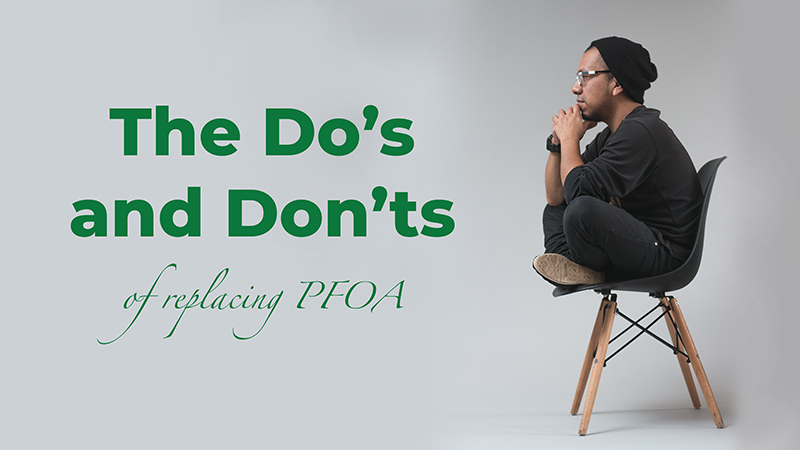Four approaches to substitution your company should start considering
Written by Amit Paul, Managing Director at Paxymer
As the managing director of a SME with its own sustainable technology I spend a lot of time thinking about how to achieve successful green substitution and about what the constituents of this process are. I recently got a chance to bounce my own ideas off others when I took part in a Chemical Watch seminar in Copenhagen. During the seminar two things stood out for me:
- Substitution is often defined as switching one chemical component for another chemical component, one CAS number for another one albeit with less H and R phrases. However in our company we almost never talk of substitution in this way – and our business model is to create new solutions that address environmental and health issues. Instead we focus on functionality of the final product and on adding value to our customers’ customer. We never focus on simply replacing substance A for substance B.
- The seminar audience was mostly made up of substitution professionals and product stewards and yet one of the main reactions to my talk was: “I never hear that substitution is a source for innovation. I always hear that I am in compliance and that for the company to actually start innovating I need to get out of the way.” At Paxymer we think of substitution as an important chance to innovate and to increase customer value and gain market share.
At the face of it the driver for substitution and chemicals management is simple – greener and safer chemicals are the only sustainable path forward.
However, there are a whole array of excuses for not implementing substitution:
“Our customers will not pay a green premium.” No customers will pay unless they see a benefit.
“We are already working with compliant solutions.” Yes, but for how long will these solutions stay compliant?
“The alternative is more expensive than our current substance.” Is the alternative really more expensive if you factor in the total cost of the current substance including permits, waste handling, worker safety etc?
I am sure you have heard these excuses and perhaps even used them yourself!
Here are some counter arguments that will hopefully allow you to create an environment in your company that is conducive to substitution and innovation.
1. Value not cost
The focus of a company should be on the value it delivers to the customer. If we can market value we can also price the product as such. If we only switch component A for component B we will have a hard time motivating an increased price. But if we provide the customer with a new and improved solution to their need the price issue will likely be of less importance.
2. Process not component
This relates to the topic of cost. Have you considered the cost savings of personal protective equipment, of not having to deal with hazardous waste and with separate waste streams, of being able to recycle materials and the fact that the overall formulation could change meaning you might be able to eliminate other components? You should! Compare the total cost of one system with another, not simply one component with another.
3. Proactive not reactive
Most companies still wait until the last minute even though it has been said so many times it is almost a cliché: Be proactive. Proactive means you can afford to be systematic and not take the first acceptable solution. It means you can stress test your solutions and solve problems when they arise. All new technology will have issues when scaling up. If you do your homework, the problems will amount to a speed bump, not a disaster. Concrete targets, set timelines and a pragmatic approach are critical to achieving efficient substitution. Not “we will switch as soon as we have the perfect product”! This typically means you will end up in a race against the clock no matter how early you started.
4. Purpose not project
Companies that treat substitution as isolated projects expose themselves to potentially very high costs. This is partly due to the frequent substitution of one chemical for another and partly due to the risk of so-called regrettable substitution in which you pick the nearest chemical “cousin”.
Companies that are great at using substitution as a driver for innovation typically have a strong vision. For them, substitution is driven by their organizational purpose or vision – not by the gradual elimination of banned chemical substances on a project-by-project basis. Companies with a strong vision typically also attract involved and committed employees. Both are imperative for the creation of successful substitution driven innovation processes.
In an ideal world substitution can be a trigger for long-term solutions that create value in more sustainable companies and safer use of chemicals. From first hand experience I know that an attitude change in this direction increases success rates, reduces total substitution costs and increases value creation for customers.
Doesn’t this sound good? My challenge to you is this: Get out there and try it! What have you got to lose?
About Paxymer
Paxymer is a start up with its own technology within halogen free flame retardants. More specifically its product boosts the performance of existing solutions. The industry is challenged to deliver cheap, functional, green flame retardant materials. Paxymer’s technology enables just this. To find out more visit www.paxymer.se.
You can find Paxymer’s Marketplace ad here.

Amit Paul
Managing Director, Paxymer






